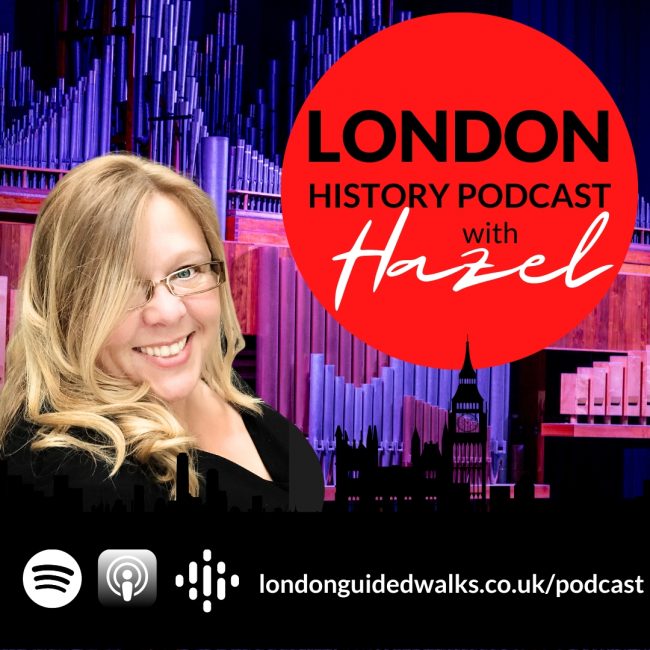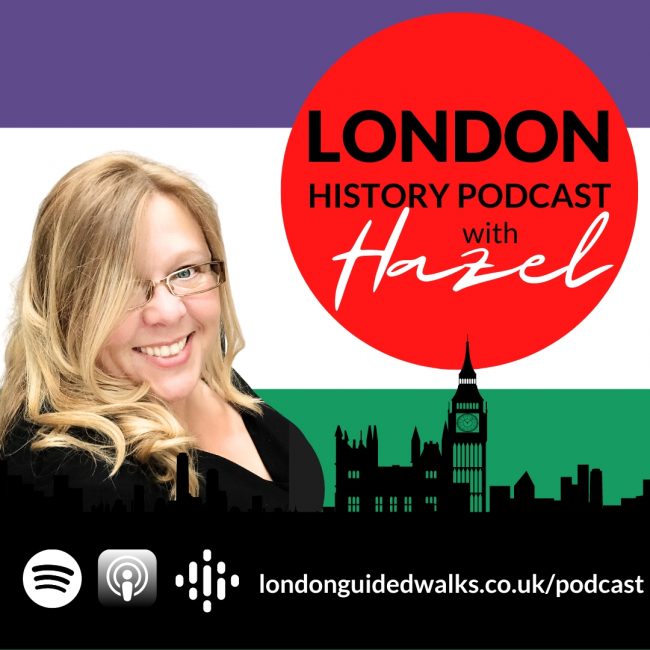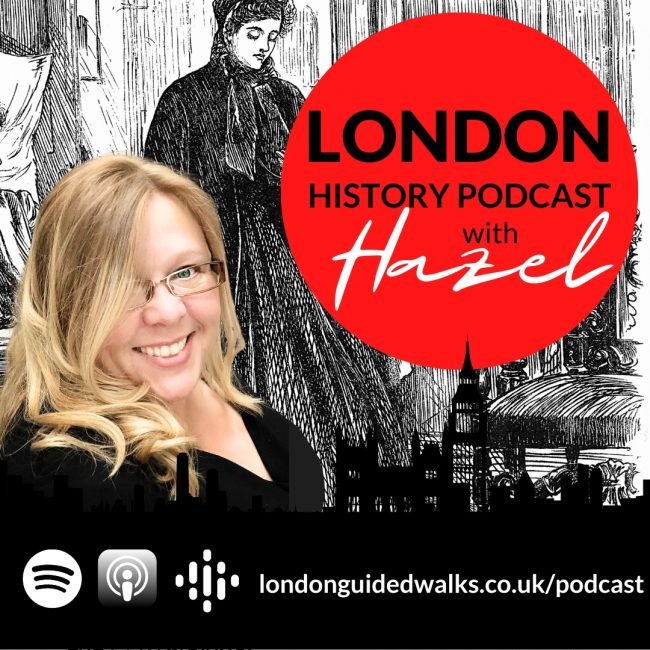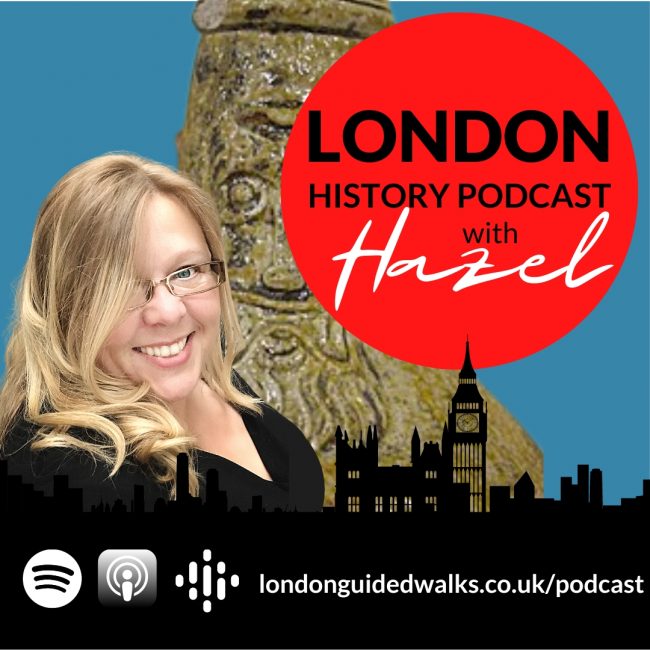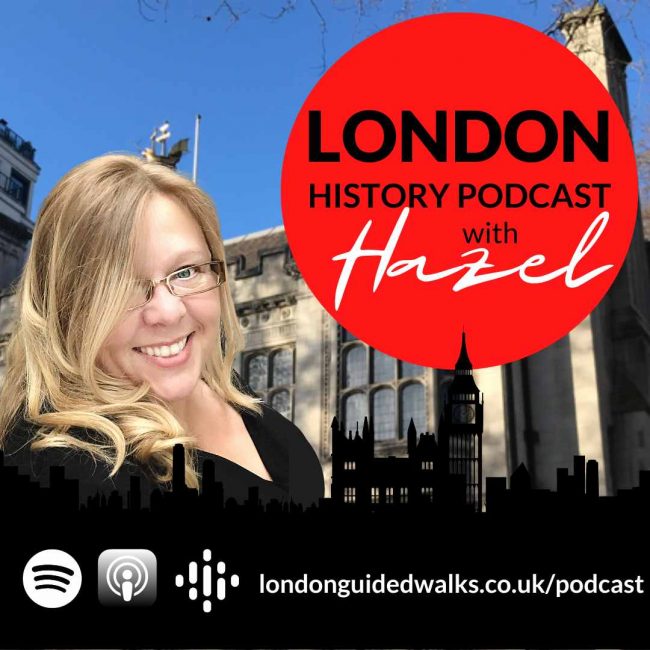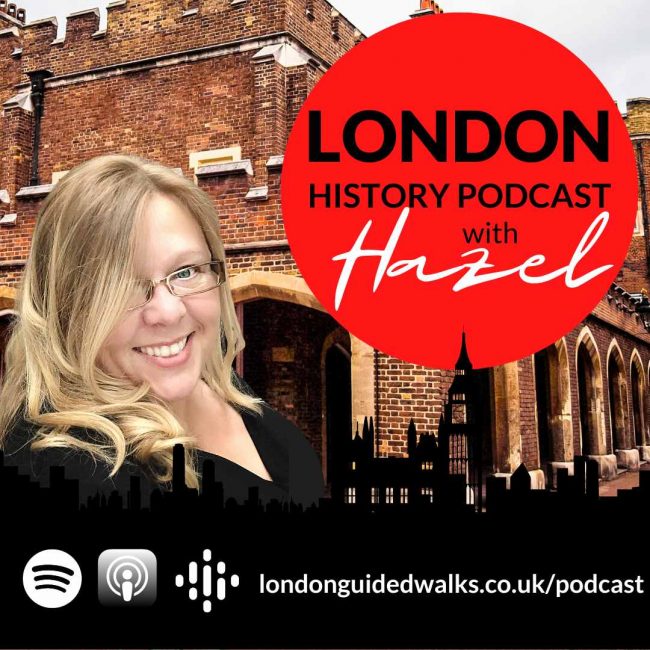With over 3,000 pubs in London, we have handpicked some of the most interesting places and unique facts for you to start adding these pubs on your ‘Places to Visit’ list.
London’s Historic Pubs
Show Notes:
 Hazel Baker: Hello and welcome to London Guided Walks London History podcast. In the coming episodes, we will be sharing our love and passion for London, its people, places and history in an espresso shot with a splash of personality. For those of you who don’t know me, I am Hazel Baker, founder of London Guided Walks, providing guided walks and private tours to Londoners and visitors alike.
Hazel Baker: Hello and welcome to London Guided Walks London History podcast. In the coming episodes, we will be sharing our love and passion for London, its people, places and history in an espresso shot with a splash of personality. For those of you who don’t know me, I am Hazel Baker, founder of London Guided Walks, providing guided walks and private tours to Londoners and visitors alike.
To accompany this podcast, we also have hundreds of London history related blog posts for you to enjoy, absolutely free. We’ve also launched The Daily London, providing you with daily inspiration of things to do in London for Londoners. You can listen on iTunes, Spotify, or even add it to your Alexa flash briefings. And you can check all of that out on our website londonguidedwalks.co.uk/flash.
And don’t forget too that we’re also offering a September sale. You can get 20% off any private tour booked by the end of this month. You can book it for summer next year, it doesn’t matter, as long as you use the promo code SUMMER2020.
And now for this week’s theme, London’s Historic Pubs. The pub is a great British institution. And as you would expect, London has a number of watering holes that have been around for centuries.
There’s no better experience than having a drink in one of the many historical pubs dotted throughout London. No matter which part of London you’re staying in or what kind of drink you enjoy, there’s always a great local boozer just around the corner. With over 3000 pubs in London, we at London Guided Walks have handpicked some of the most interesting places and unique facts for you to start adding these pubs onto your places to visit list. Joining me in the studio today is city of London tour guide Ian McDiarmid. Hello there.
 Ian McDiarmid: Hello hello.
Ian McDiarmid: Hello hello.
Hazel Baker: So are you a pub kind of guy?
Ian McDiarmid: Yes and no. In the sense that I’ve always enjoyed going in them. I like beer very much. And I think that real ale is… I just don’t understand foreign people, this is a sweeping generalization, I don’t understand why foreigners don’t like it like Germans and Belgians, always very big about their own beer.
And then they, again, sweeping generalization. So apologies to all Germans and Belgians, but come over here and tend to be a bit sniffy about our beer. The thing is with English beers, it’s got a complexity to it that other, beer, continental beers just don’t have. Okay, it’s a bit different. You’re drinking beer at room temperature and they’re used to drinking cold beer, but I mean, I just don’t understand why they didn’t get the point of it. But, yeah, apologies for making sweeping generalizations.
Hazel Baker: And, you know, we do have people from Belgium and Germany listening to us.
Ian McDiarmid: I really like Belgians and Germans. I want to make that very, very clear. I’m sure that there are probably many, the ones listening are probably very angular file and loving English beer. But anyway, having said that, I love English beer and pubs, the problems that I have with pubs, and again, this is… I’m in dangerous territory. I’m in danger of sounding very very grumpy, oddly enough.
Hazel Baker: Really?
Ian McDiarmid: Yeah. The things I don’t like about pubs are the noise. When they have background music, so this is something intrinsic to pubs. And I don’t like loud fruit machines.
Hazel Baker: No.
Ian McDiarmid: And I don’t like hideously crowded places. So if you can find an empty pub with no background music, which has rather nice historical features
Hazel Baker: And that serves ale.
Ian McDiarmid: And that serves proper beer. Yeah. Then, then I’m very happy. How about you?
Hazel Baker: Oh, well. I like somewhere to sit, you know? When I had a real job, an office job, I’ll be wearing heels and then you’re expected to go somewhere and stand and drink, which is just really awkward. When you’ve got your handbag, you got heels. It’s been a long day. And also, I mean I’m 5’7 but I’m still way shorter than most of the men. And you just get pushed around. So I like somewhere to sit and also going to the loo. I mean, if you need to go, I don’t want to be having to step over puddles or holding my nose. And that is usually, you know, one of the downsides of going out, and this is not, you know, I’m not going out late at night. This, it could just be you’re on a regular Saturday afternoon, you know?
Ian McDiarmid: Yeah. I’m in danger of offending certain people from the continent. You’re in danger of offending a lot of people who run pubs by saying that.
Hazel Baker: Well, why don’t you just clean the toilets quicker and better?
Ian McDiarmid: Okay. We should mention that. Any assumptions we’re going to mention today have pretty good toilets. Haven’t they?
Hazel Baker: Yeah, we’ve tried it. Yeah. So the good thing about COVID and the bounce back is that we’ve been able to investigate a number of pubs that have reopened, and we have had plenty of space in which to swing by a lot, haven’t we?
Ian McDiarmid: Yeah. And I’m probably like a lot of people I’ve been rather suffering through COVID through getting thoroughly fed up with it. But one good thing has been being able to go and visit pubs that I’ve, that I’ve never… I haven’t said I like pubs. I don’t go in them that often. And I think one of the things that, particularly living in London, but anywhere where you’ve got a so-called nice pub that people know about is that often you’ll open the doors, you’ll see it absolutely thinking, ah, I’m not going to bother.
So this past month or so, we’ve really been making an effort, haven’t we? To go into some pubs that you well, that you, you know, you’re doing your pub tour. Hazel does a historic pub tour in the Covent Garden area. And one of the pubs she mentioned is on that tour is the Salisbury, which I went into for the first time with her so I had my own, guided tour with all the background, which was good. And it’s a really good pub, isn’t it? And I was about to say why I like it, but could you give us a bit of background on the Salisbury and why it’s such an interesting pub?
Hazel Baker: Yeah. Well, what’s nice is that you actually get to see some of the interior detail that you couldn’t do before. There’s several things that you get to notice with the etched glass, which you wouldn’t normally, because you’d be opening the door for someone else’s, you’re going through, and that kind of thing, but it has the original, U shape bar. It’s all great to list that. It has some wonderful, authentic, art nouveau, light fittings as well. So this is when electricity was added to the pub. And also it has a glass section in the ceiling of the pub looking up to a fantastic spiral staircase, showing what are now flats, but there used to be a room so you could stay at the Salisbury, and also have a drink downstairs.
Ian McDiarmid: Yeah, that was amazing. It was one of the barmaids kindly pointed out to me as I was wandering around rather aimlessly and yes, it’s so tall. I mean, massive. It was in fact, a hotel, isn’t it?
Hazel Baker: Yeah. Yeah, exactly. And it’s nice that they’ve kept the sort of original colours as well, because of course that dark red was really popular in Victorian times cause of course you had gas lamps. So the by products of that and all that would have congregated on the ceiling and also all the smoking that would have gone on. Having a dark colour, even though it’s colour, it’s still dark. So it’s just covering up a lot of the mess.
Ian McDiarmid: Yeah. And I having done my grumpy old man thing at the beginning, I start talking about things I dislike in pubs. It’s very reassuring to go into a pub like that, where they’ve got the original fittings. I mean, cause so many of them have been, were ruined in, I guess, the 70s
Hazel Baker: Still are, as well.
Ian McDiarmid: Yeah, because they, where they’ve got their original fittings, obviously they don’t fit in so well with the background music and fruit machines, they can’t accommodate them so it’s a good sign. And I guess that there’s probably a grow- I don’t know, but I imagine that there’s a growing market now for proper pubs. Because there’s an, obviously the campaign for real ale has been around for a long time, thankfully, but also that seems to have coincided recently with the craft beer movement. Authentic drinking should be in somewhere that’s interesting rather than somewhere that’s just, yeah, some kind of factory produced drinking space.
Hazel Baker: Yeah. Well, I bet you don’t know what the most expensive pint in London is then?
Ian McDiarmid: I find it difficult-
Hazel Baker: It’s a pint.
Ian McDiarmid: I dunno. It’s difficult. I’ve got 69 P stuck in my head. Cause I think that’s how much it was when I was a student. A pint varies enormous, doesn’t it? From about 3 pounds to about 6 pounds now? So the most expensive, is that right? Would you say?
Hazel Baker: Oh, I’m waiting for you to give you final answer.
Ian McDiarmid: Yeah. The most expensive p…well it’s only beer, isn’t it? You can’t be that expensive, can it? I would say the most expensive pint is going to be 12 pounds.
Hazel Baker: Well, you’re close, but not very close. At Speedway Stout by the craft beer company, is 22 pounds 50 a pint.
Ian McDiarmid: A pint? 22.50. Wow. Where, do you know where that is?
Hazel Baker: You can get it at the Ryan Borough Market. It’s one of the places. It’s quite a small pub as well. One of the teeny weeny ones.
Ian McDiarmid: And then you could go out and spend several hundred pounds on fish and cheese in Borough Market.
Hazel Baker: Yeah. It could be a very expensive diet content. Yeah.
Ian McDiarmid: Now Hazel, how did public houses originate?
Hazel Baker: Hm. It depends how far you want to go back really. But I suppose, looking at it, it’s the Romans that we’ve got to thank for this. This is looking at the Roman system or the road system connecting across the continent. And then of course, into Britain, all roads lead to Londonium, and as you’re traveling well, are you going to get thirsty and tired? You’re going to need a rest to stop over the night. And so they had ins. They’re called Bernay and that’s where you’ll be able to get your lodgings and your refreshments. So that’s how it all kind of started.
In more recent years, it was a space where basically, you know, if you know term public house, it was a house in the street, which was where the locals would come and go. This is where you’d have your, your community would be, there’d be no community halls. And also this is where not of the, the local laws, would have, law courts would have happened as well. This was your, local community hub. This wasn’t just a place. We’ve got the mines now.
Pubs you think of, lots of loud men drinking, but these were a useful place where everybody could come and do their business and see people and catch up and talk about the things they did the other day.
Ian McDiarmid: Now, one of the most obvious features of a pub is its sign. Can you tell us something about how those originated?
Hazel Baker: Yeah. Pub signs. And this was, 1393 really was when an act was passed by Richard II and this made it compulsory for pubs to have a sign outside. This was so the official ale taster when going around, he would be able to identify the pub from any other types of business.
Ian McDiarmid: Okay. So I can see that having a pub sign would be a distinct disadvantage necessarily if you wanted to avoid the official ale taster.
But on the other hand, I would’ve thought that’d be quite. No, maybe they wouldn’t, I’ve just been, say quite vital in attracting customers. But on the other hand, if I suppose if you, it depends who you’re relying on for your customers, doesn’t it? If you want to attract people who are not familiar with the area, you need a pub sign to say, meet me at the sun or whatever. But if you’re in a village, then everyone would know where the pub was anyway.
Hazel Baker: Yeah exactly. So it does, it does depend on, and of course, pubs are going to be on main roads most of the time anyway, for passing trade. And don’t forget most people who couldn’t read. So you need some sort of iconic pub sign to make you stand out compared to any other pub in the area.
Ian McDiarmid: And do you have a favourite pub sign?
Hazel Baker: Well, I used to have a favourite pub sign. it was the Three Kings in Clerkenwell. And that’s just between the parish church and Clerkenwell Green. That was quite a fun one. Do you want to have a guess who are the three Kings that were on this pub sign?
Ian McDiarmid: Oh, so many Kings. Henry V, George I, Henry VIII,
Hazel Baker: You’re a third right. Henry VIII is certainly on it as well as King Kong and Elvis, the King Presley.
Ian McDiarmid: Oh yeah. Well, they will learn English Kings, right?
Hazel Baker: Yeah. So a few years ago, the sign just disappeared and it hasn’t been replaced. So actually doesn’t have a pub sign at the moment.
Ian McDiarmid: The building’s still there though.
Hazel Baker: The building’s still there. Yeah. The brewer sign is still there. There’s still the pub. It reopens in next weekend. But yeah, no pub sign. So, yeah, that was a favourite one of mine just because it was quite quirky and also it wasn’t just painted. It was 3D. I kinda liked the Two Chairmen in St. James’.
Ian McDiarmid: Oh, yeah. Now, having said I haven’t been in that many pubs. That’s one that’s one I do know.
Hazel Baker: Yeah. So that’s a nice one, because you show these, these two chairmen with a long coat and they’re carrying a sedan chair, which was a very popular method of transport if you could afford it. And that, in St. James’ it’s believed to be one of the oldest pubs in Westminster as well. And the sign itself, the one that you can see, it shows back from 1729.
Ian McDiarmid: Really?
Hazel Baker: Yeah. Which is great. Isn’t it?
Ian McDiarmid: Yea because most of these signs are modern, aren’t they?
Hazel Baker: Yeah.
Ian McDiarmid: Yeah. That’s great.
Hazel Baker: And, Oh, I’ve got a question for you now. So, what’s the connection between the Two Chairman in St. James’ and Mary Poppins Returns in the film?
Ian McDiarmid: Oh, I have no idea.
Hazel Baker: It’s in it! Yeah. So at the very beginning-
Yeah, well, you know, you missed out. So yeah, so this is when the very first scene and you’ve got the chimney sweep and he’s on his bike and he’s singing out about our London town in the worst London accent since.
Ian McDiarmid: Is it –
Hazel Baker: Mary Poppins Return. So let’s do it in the London accent since from, yeah, absolutely-
Ian McDiarmid: They’ve got this tradition of terrible London accent search. They wanted to mention-
Hazel Baker: That’s right but he was in Hamilton, you see? So he’s a big name. Anyway, so he’s cycling down, singing how lovely our London town is, and the kids, just at the bottom of this little alleyway as he lights a lamp. And that is where the Two Chairman is!
Ian McDiarmid: Okay. And are there any other pub signs you’re particularly fond of or interested in?
Hazel Baker: Interested in? Well I like Ye Old Mitre that’s in Hatton Gardens.
Ian McDiarmid: Oh I like that. That’s one I have been in.
Hazel Baker: There you go. It is a splendid pub. And people say that they ve’ never been there when we go on our Bleeding Hearts and Body Parts Tour or that they just can’t find it. So it’s one of those places you kind of, once you’ve been, you know.
Ian McDiarmid: I liked the idea of a pub that’s hard to find.
Hazel Baker: Yeah, but The Hung, Drawn, and Quartered pub sign, that makes me laugh. That’s fine. They’re at the Tower of London. I know you know it. What I love about this sign it’s yeah, it’s okay. It’s painted on as most of them are. But it does look like it’s for guys who are just having a bit of an argy bargy outside the pub and the tower in the background on this side is quite funny. Nothing about being hung, drawn and quartered evident from this pub zone.
Ian McDiarmid: The one I like is the Old Doctor Butler’s Head, which again, I’ve spent a hell of a long time in the city wandering around it, but I’d never been in and then you covered it at the time, we went in and it was very quiet . Because that’s a place that, this is near Moorgate down an alleyway and Mason’s alley, isn’t it? Yeah. So this is one of the city’s historical pub.
Its origins go back to the early 17th century, was burnt down in the great fire and rebuilt, but looking at it as it looks early 19th century.
And I have to say that actually it’s a little bit, I found it a little bit disappointing on the inside. It’s fine, but it’s, unfortunately got sky television in, it’s run by Shepard names that might explain that as a brewery, a big chain. But anyway, it’s nice inside, but the main attraction of it is that early 19th century, exterior, it looks quite dependent, doesn’t it?
Hazel Baker: Yeah but the whole pub idea is that you are to have e nice experience in the pub, not just looking at it from the outside.
Ian McDiarmid: Yeah, I kind of liked it, but it wasn’t, I haven’t gone in there for the first time. I was a little bit disappointed, but the staff in there were very, very nice. Weren’t they?
Hazel Baker: Yeah. They tried.
Ian McDiarmid: And, yeah. So this is interesting from a historical point of view because of Dr. Butler himself, who was a main court physician to King James I. And he had his ale and he sold his ale from pubs with his head painted on their sign. And this is the last of several pubs that did this to have survived, and inverted comments. Cause it’s been on that site, but the building’s changed. And so they’ve got this more, obviously modern pop sign of Old Dr. Butler up there. So that’s quite interesting I think.
Hazel Baker: Yeah. I was excited to find a new pub as well. That was fun for me.
Ian McDiarmid: Yeah. Yeah.
Hazel Baker: I know, you know this one, but I’m going to ask the listeners, what is the most popular pub name in the UK? Give you a moment to have a little ponder. And Ian, would you like to reveal?
Ian McDiarmid: Yes. And I know this only because you’ve told me so many times. The most common pub name is The Red Lion.
Hazel Baker: And what about The Red Lion on White Hall? You’ve got a good fact about that.
Ian McDiarmid: Yeah. Well, The Red Lion on White Hall, which is just on the end of White Hall, doesn’t it? Into parliament square. That is one of the division pubs and the division pubs is, there’s several of them but they ha- They’re called division pubs cause they have a bell in them. So when there’s a vote in the house of commons, they ring this division bell and are responsible representatives are members of parliament can then rush back to the house of commons to participate in the vote.
Hazel Baker: I do think that that they should be breathalysed before they vote, though.
Ian McDiarmid: Yeah, but then they wouldn’t have to rush back, would they? I mean… So one final question for you, expert on historic pubs, and it’s rather than obvious question is what is the oldest pub in London?
Hazel Baker: Ugh, no, plead the fifth on that one. Yeah. There’s no real answer. Here’s how you measure it. So in terms of actual physical building, the seven stalls on Carey St., which is just our Fleet St., that has got to be one of my favourites.
I mean, it’s great to list it, large parts of the building are from the 1680s, but there are date marks from the building declaring that some elements of it are from 1602. So that makes it a rare survivor of the Great Fire of London. Historic in its own right.
Ian McDiarmid: Is that comparable to the Mitre? I was going to say that I’ve not been in this one. Is it as nice as the Mitre?
Hazel Baker: Well, there’s more place to sit down.
Ian McDiarmid: Okay. I’ll have to give that one a go then.
Hazel Baker: So you know what you can do, you can come along on one of our Historic London Pub Tours and experience some of the best and most interesting Historical London Pubs with us!
If you enjoyed this episode, it would be really great if you were able to take a few minutes and leave an honest review and rating, that’s all for now, we’ll catch you next week.

